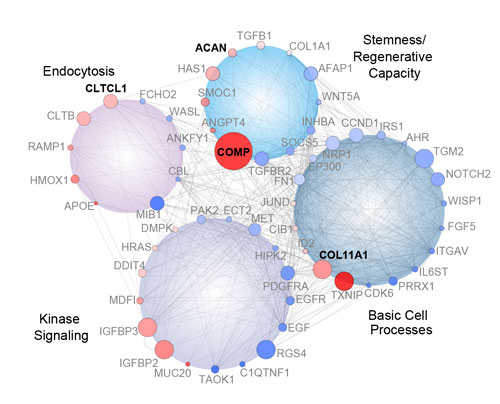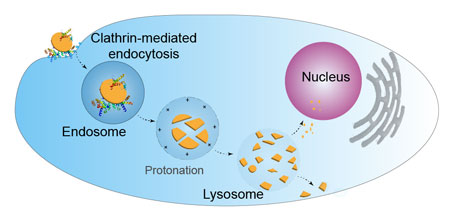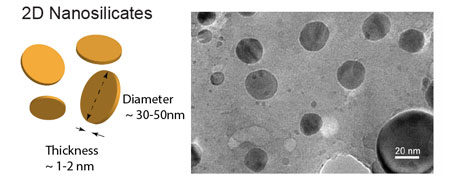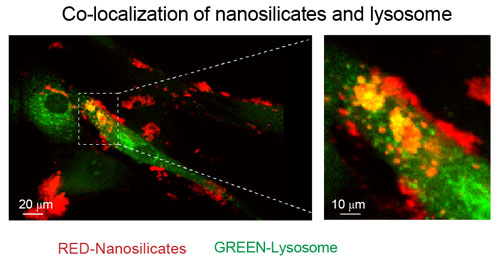| Posted: Apr 13, 2018 | |
Nanosilicates grow bone and cartilage tissue from stem cells in the absence of growth factors |
|
| (Nanowerk Spotlight) Human stem cells have shown potential in medicine as they can transform to various specialized cell types such as bone and cartilage cells. The current approach to obtain such specialized cells is to subject stem cells to specific instructive protein molecules known as growth factors. | |
| However, use of growth factors in the human body can generate harmful effects including unwanted tissue growth, such as a tumor. | |
| In new work reported in PNAS ("Widespread changes in transcriptome profile of human mesenchymal stem cells induced by two-dimensional nanosilicates"), researchers at Texas A&M University have demonstrated that a specific type of two-dimensional (2D) nanoparticles, nanosilicates, can grow bone and cartilage tissue from stem cells in the absence of growth factors. These nanoparticles are similar in shape to a coin, but 10 billion times smaller in size. Nanosilicates consist of minerals such as sodium, silicate, magnesium and lithium, which are already present in the body. | |
 |
|
| Image showing gene network displaying interconnected genetic targets after nanosilicate treatment with high degrees of expression and statistical significance (red—upregulated, blue—downregulated; size increases with significance). (Image: Inspired Nanomaterials and Tissue Engineering (iNanoTE) Lab, Texas A&M University) (click on image to enlarge) | |
| The capability of investigators to accurately and sensitively discern changes in cell behavior after nanomaterial treatment requires them to pick biomolecule targets, like genes or proteins of interest, ahead of time. While research is driven by scientifically-based hypotheses, sometimes cell outcomes can be difficult to predict, especially for unexplored nanomaterials. | |
| The process of RNA-sequencing provides researchers a means to capture a broad view of cell function of a cell population or even a single cell. Using emerging bioinformatics techniques, they can uncover signaling pathways or genes that were not previously considered. | |
| 2D nanomaterials have emerged as a new generation of materials due to their unique properties relative to macroscale counterparts. However, little is known about their interactions with human cells following exposure to these nanomaterials. The Texas A&M team investigated the interactions of 2D nanosilicates, a layered clay, with human mesenchymal stem cells (hMSCs) at the whole transcriptome level by high-throughput sequencing (RNA-seq; also called whole transcriptome shotgun sequencing). | |
| RNA-seq uses next-generation sequencing to reveal the presence and quantity of RNA in a biological sample at a given moment. RNA-seq is used to analyze the continuously changing cellular transcriptome. | |
| Cells use genetic code (DNA) to produce different genetic messages to direct certain cellular functions such as to form new bone, blood vessels, skin, etc. These messages are called mRNA (or transcriptome) and perform a variety of functions, one of which is to instruct cells on how to behave. So, the transcriptome is the set of all RNA molecules in one cell or a population of cells. | |
| The term “whole-transcriptome” means that scientists are looking at all of these messages (mRNA) sent within the cell at a single point in time. | |
 |
|
| Image showing how nanosilicates direct differentiation of stem cells towards bone and cartilage lineages. (Image: Inspired Nanomaterials and Tissue Engineering (iNanoTE) Lab, Texas A&M University) | |
| "From our study, we demonstrated that nanosilicates exhibit some very interesting capabilities when applied to adult human stem cells," Akhilesh K. Gaharwar, an Assistant Professor at Texas A&M University and senior author of the paper, tells Nanowerk. "When these stem cells are treated with nanosilicates, they start showing behavior that is typically observed during regeneration of bone, and cartilage. This indicates strong biomedical potential for these nanoparticles to be used as a possible therapy for osteoarthritis or orthopedic-related diseases osteoporosis." | |
| 2D nanosilicates are highly bioactive and have shown to direct the change or differentiation of human stem cells towards bone and cartilage tissue. The cellular response to nanosilicates is believed to originate from the unique physical and chemical composition of the nanoparticles. This premise of mineral-based particles affecting cell behavior has opened the doors to the development of new class of therapies, specially for osteoporosis or arthritis/osteoarthritis as described below. | |
|
Osteoporosis causes bones to become weak and brittle — so brittle that a fall or even mild stresses such as bending over can cause a fracture. 2D nanosilicates can act as a unique additive that can help stimulate bone growth. If these nanosilicates can be delivered to bone cells, then they can stimulate bone cells to deposit bone matrix, that can strengthen the surrounding weak bone. Osteoarthritis is characterized by progressive degradation of cartilage and often localized to joint spaces. Due to the lack of vascularity within intra-articular spaces, systemic delivery of morphogens and growth factors supporting cartilage matrix synthesis often results in limited improvement. These 2D nanosilicates can be delivered to intra-articular space to stimulate chondrocytes to synthesize new cartilage matrix. |
|
| RNA-seq, which the research team employed here, is a powerful tool for an accurate quantification of expressed transcripts that largely overcomes limitations and biases of microarrays. The technique uses next-generation sequencing to reveal the presence and quantity of RNA in a biological sample at a given moment. | |
| For example, cell-nanoparticle interactions can result in significant change in cellular behavior that can be observed by using this technique. | |
| In layman’s terms: RNA-seq takes a snapshot of gene activity of the cell at any given moment. This is similar to taking a high-resolution photo during the Super Bowl and identifying the reaction of every fan during the touchdown. | |
 |
|
| Schematic showing shape and size of 2D nanosilicates. Electron micrograph show actual size of nanosilicates. (Image: Inspired Nanomaterials and Tissue Engineering (iNanoTE) Lab, Texas A&M University) | |
| "RNA-seq is very sensitive to investigate the interaction of a wide variety of nanomaterials with cells," explains Dr. Irtisha Singh, a co-investigator of the study. "With the combination of nanotechnology and computational biology, we can better understand how material’s chemistry, shape, and size can contribute to cell functions. Understanding cellular responses following treatment with nanomaterials will aid in evaluating their application for a range of biomedical and biotechnology applications." | |
| In this present work, the scientists investigate the interactions of 2D nanosilicates with human mesenchymal stem cells (hMSCs) by employing transcriptome dynamics to uncover triggered biophysical and biochemical cellular pathways. In doing so, they observed widespread changes in gene expression profile (>4,000 genes) following nanosilicate exposure, which has not been reported previously. | |
| In addition, transcriptomic dynamics of nanosilicate-treated hMSCs identifies key genes and enriched gene ontology pathways and categories related to stem cell differentiation, specifically toward osteochondral lineages. | |
| "We validated the RNA-seq findings using in vitro studies, which support the ability of nanosilicates to direct hMSC differentiation toward bone and cartilage lineages," Gaharwar notes. | |
| He points out that this study also investigated surface-mediated kinase signaling triggered by 2D nanosilicates. "This work enables further development of nanomaterial-based therapeutics for regenerative medicine. More generally, transcriptomic analysis by next-generation sequencing provides a comprehensive and objective snapshot of cellular behavior following nanomaterial exposure/ attachment." | |
| "Furthermore, this study demonstrates the utility of next-generation sequencing for the study of cellular interactions on nanoengineered substrates and the role this approach is likely to play in this rapidly expanding field of regenerative medicine." | |
 |
|
| Image showing internalization of nanosilicates by human stem cells. (Image: Inspired Nanomaterials and Tissue Engineering (iNanoTE) Lab, Texas A&M University) | |
| The current study was performed using human cells in in vitro to show that nanosilicates can be used to grow bone and cartilage tissue. The team's next step will be to demonstrate the formation of bone and cartilage in vivo. | |
| Specifically, they are looking to develop implantable scaffolds containing these nanosilicates to improve local tissue growth for both bone and cartilage. | |
| "Moreover, we will use computational biology and genomics to design next generation of bioactive materials for regenerative medicine," says Gaharwar. | |
| The ability to customize a therapy to a specific tissue, simply by changing the mineral content within the nanoparticle, presents a great potential within the field of regenerative engineering. | |
| "We believe this new field of Mineralomics can provide a viable alternative compared to the current treatments existing today," conclude James Carrow and Lauren Cross, graduate students in Gaharwar's Lab and co-first authors of the paper. "From a technological perspective, there is a greater push to incorporate ‘big data’ into experimental biology and bioengineering through improved modeling and analytics. This coupling of computer science with biology has the potential to accelerate the discovery of new and beneficial regenerative therapies. The public availability of data from these gene expression studies provides a great service for those looking to find new trends in cell behavior." | |
 By
Michael
Berger
– Michael is author of three books by the Royal Society of Chemistry:
Nano-Society: Pushing the Boundaries of Technology,
Nanotechnology: The Future is Tiny, and
Nanoengineering: The Skills and Tools Making Technology Invisible
Copyright ©
Nanowerk LLC
By
Michael
Berger
– Michael is author of three books by the Royal Society of Chemistry:
Nano-Society: Pushing the Boundaries of Technology,
Nanotechnology: The Future is Tiny, and
Nanoengineering: The Skills and Tools Making Technology Invisible
Copyright ©
Nanowerk LLC
|
|
|
Become a Spotlight guest author! Join our large and growing group of guest contributors. Have you just published a scientific paper or have other exciting developments to share with the nanotechnology community? Here is how to publish on nanowerk.com. |
|
